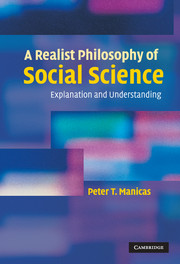Book contents
- Frontmatter
- Contents
- Acknowledgements
- Introduction
- 1 Explanation and understanding
- 2 Theory, experiment and the metaphysics of Laplace
- 3 Explanation and understanding in the social sciences
- 4 Agents and generative social mechanisms
- 5 Social science and history
- 6 Markets as social mechanisms
- Appendix A The limits of multiple regression
- Appendix B Comparison, Mill's methods and narrative
- Appendix C Rational choice theory and historical sociology
- Appendix D The neo-classical model
- References
- Index
Introduction
Published online by Cambridge University Press: 12 November 2009
- Frontmatter
- Contents
- Acknowledgements
- Introduction
- 1 Explanation and understanding
- 2 Theory, experiment and the metaphysics of Laplace
- 3 Explanation and understanding in the social sciences
- 4 Agents and generative social mechanisms
- 5 Social science and history
- 6 Markets as social mechanisms
- Appendix A The limits of multiple regression
- Appendix B Comparison, Mill's methods and narrative
- Appendix C Rational choice theory and historical sociology
- Appendix D The neo-classical model
- References
- Index
Summary
This volume reassesses the problem of explanation in social science from what remains a marginalized, realist perspective. Because the problem of explanation is central to inquiry in social science, the volume also provides a systematic philosophy of social science. It begins with the idea that the fundamental goal of theory in both the natural and social sciences is not, contrary to widespread opinion, prediction and control, or the explanation of events (including “behavior”). Rather, more modestly, theory (at least in one of its clear senses) aims to provide an understanding of the processes which jointly produce the contingent outcomes of experience. We understand why the planets move in ellipses, why materials burn, and why salt dissolves in water (if and when it does) when we have a physical theory that provides a causal mechanism. By providing the principles detailing the nature of molecules, the atomic structure of salt and water, the principles of their action, and so on, we can understand combustion and solubility – and other chemical processes. Indeed, while the theoretical work of physical scientists often begins with the effort to understand patterns, they are not interested in, nor generally capable of, providing either “explanations” or “predictions” of particular events. For example, the trajectory of a boulder splintering as it rolls down a hill is fully understood in terms of physical principles, but neither the trajectory nor the final positions of the splintered parts can be explained or predicted.
- Type
- Chapter
- Information
- A Realist Philosophy of Social ScienceExplanation and Understanding, pp. 1 - 6Publisher: Cambridge University PressPrint publication year: 2006

